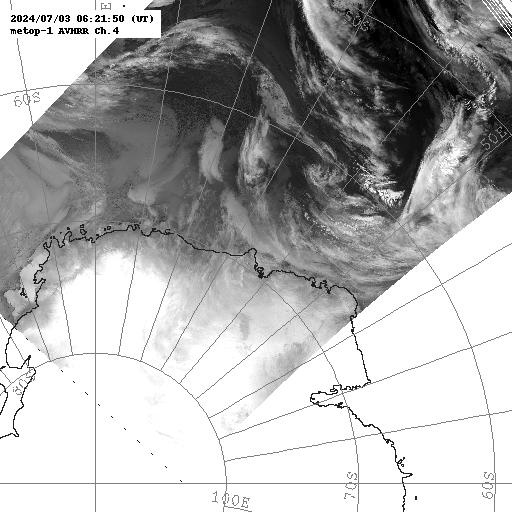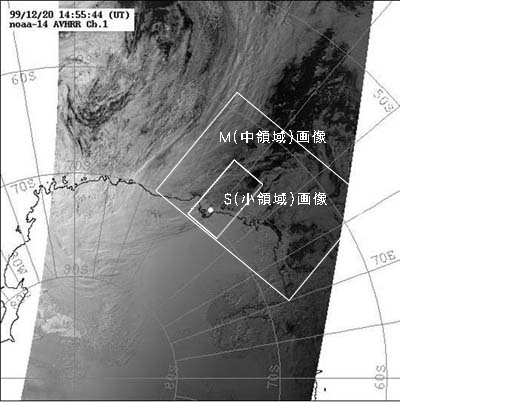AAA 南極 昭和基地における地球観測衛星データの受信
AAAMeteorological and Glaciological Research AAAAAAAAAA気象・雪氷研究
AAANOAA, Metop, Terra, Aqua, NPP, JPSS, Received at Syowa Station, Antarctica
that has been supported by Japanese Antarctic Research Expedition (JARE).
| The latest infrared image of NOAA, received at Syowa (最新の赤外画像) |

|
Science database for satellite QL images Check data usage policies and DOIs AVHRR QL Images Search 【QL画像】簡単検索 MODIS QL Images Search 【QL画像】簡単検索 NIPR ADS Gallery 【画像】検索 JARE 衛星モニタリングのページ Satellite Receive System 受信システム 南極の水循環のページ/平沢 南極に行きたい方 画像ご利用時お知らせください |
|
| IntroductionAAAAはじめに
|
|||||||||||||||||||||||||||||||||||||||||||||||||||||
|
The following discribes the data of AVHRR, MODIS, and VIIRS from the satellite monitoring project
conducted in the JARE, and the transition of the satellite monitoring project at Syowa Station. AAAAこのページは南極地域観測事業において実施されている衛星モニタリング観測によって取得した AAAAデータのうち、AVHRR、MODIS、VIIRSを処理しデータ、及び昭和基地の受信システムの変遷に AAAAついて概説します。 Searching for dataAAAAデータの検索 If you are interested in image data, proceed from the two buttons at the top of this page. AAAA画像データに興味をお持ちの方は、当ページの上部にある二つのボタンから先にお進みください。 ★ If you click Science database for satellite QL images above, you will go to the page for data publication. It is registered as one of the scientific databases constructed by National Institute of Polar Research (NIPR) and is the source of metadata referenced by international database systems. AAAA Science database for satellite QL imagesをクリックすると、データ公開のページに移動 AAAAします。そこは極地研究所が構築してきた科学データベースの一つの項目をなし、国際的なデータ AAAAベースから参照され、メタデータの提供元になっています。 ★ AVHRR QL Images Search 【QL画像】簡単検索 collects small-sized quick-look images, which have been used and cited in numerous studies and reports. AAAA AVHRR QL Images Search 【QL画像】簡単検索は容量の小さいクイックルック画像を集めて AAAAおり、これまで数多くの研究・報告書に利用、引用されてきました。 ★ MODIS QL Images Search 【QL画像】簡単検索 collects small-sized quick-look images, which have been used and cited in numerous studies and reports. AAAA MODIS QL Images Search 【QL画像】簡単検索は容量の小さいクイックルック画像を集めて AAAAおり、これまで数多くの研究・報告書に利用、引用されてきました。 ★ NIPR ADS Gallery 【画像】検索 accesses a database system operated by the National Institute of Polar Research (it can be a little confusing to proceed there). You can access high resolution data there. AAAA NIPR ADS Gallery 【画像】検索は極地研究所が運営するデータベースシステムにアクセスしま AAAAす(そこから先に進むのに少し分かりにくいかも知れません)。ここで解像度の高いデータにアク AAAAセスできます。 ★ Raw data are also available, but not automatically distributed via web pages. If you wish to use the raw data, please contact us by e-mail with the period and type of data. And then, we will exchange information on data transfer methods, data formats, the necessity of setting up joint research, and so on. AAAA 生データも利用することが可能ですが、ウェブページを介した自動的な配布は行っていません。 AAAA 生データの利用を希望する方は、データの期間、種類を電子メールでご連絡ください。その上で、 AAAA データの受け渡し方法、データのフォーマット、共同研究設定の必要性等について情報交換し AAAA ます。
Satellite monitoring of Antarctic climateAAAA南極・衛星データ受信プロジェクト
|
|
Summay of the projectAAAAプロジェクトの概要 |
AAAA本プロジェクトは日本南極地域観測隊の地球観測衛星によるモニタリング観測として1997年から実 AAAA施しています。受信されたデータは即座に1次処理され、気象庁・WMOなど、いち早くデータを必 AAAA要とする公共機関に配信しています。クイックルック画像(QL画像)は昭和基地における野外観測 AAAA・野外作業に向けた天気予報の材料として利用されているとともに、各種報告書・研究論文、研究 AAAAのための概観資料としても役立っています。これまで20年以上に渡ってアーカイブされたQL画像 AAAAは、データベースを介して取得できます(NOAA QL Images Search 【QL画像】簡単検索)。 AAAAそれと併行して、極域データシステム(ADS)へ、全データと詳細画像をアーカイブしています AAAA(NIPR ADS Gallery 【画像】検索)。 QL画像は以下のセンサーについて作られています:
|
|
|
|
|
|
|
When using QL imagesAAAAQL画像のご利用にあたって |
Free to use the images obtained from this site for education and research. Commercial use is not allowed. When publishing, it is a rule to include the credits, (c)NIPR, or to refer to URL of the relevant web page. In addition, please report that you used images to the following email address. AAAAこれらの画像は極地研究所が著作権を持ちますが、研究、教育などのご利用には制限を設けてい AAAAません。ただし、商用活動へのご利用はお控えください。 AAAAご利用いただいた場合に、ぜひ、その内容を簡単に連絡いただくことをご検討ください。いただい AAAAたご報告は、この活動が社会活動に役立っていることの証として、このプロジェクトの継続を支え AAAAています。 Your questions & reports: AAAA画像利用のご報告、お問い合わせ:
|
|
| 画像データのサンプル
|
|
昭和基地で受信されるNOAAデータの領域の広さと解像度の
目安として、広さと解像度の違う3種類の画像を
NOAA QL Images Search 【QL画像】簡単検索
のページで見ることができます。 |
L(大領域)画像は約2700km幅の短冊様のデータ範囲を確認できます。 M(中領域)画像はこちら、 S(小領域)画像はこちらをクリックすると別のウィンドウで表示されます。
| L(大領域)画像
|
| 
|
|
|
Four generationsAAAA4つの世代 | There have been four generations of satellite data receiving at Syowa Station. See Satellite Receiving System for more information. AAAA昭和基地における衛星データの受信には4つの世代がありました。 AAAA詳しくは 受信システムをご覧ください。 The first generation was implemented in the 1980s for the purpose of receiving NOAA satellites (Reference 1). AAAA第1世代は1980年代にNOAA衛星の受信を目的に実施されています(Reference 1)。 In the 1990s, the second generation using a large antenna with a diameter of 11m was developed. AAAA1990年代に口径11mの大型アンテナを用いた第2世代が展開します。 The 3rd generation, started in 1997, received NOAA satellites and DMSP satellites began with small antenna facilities (Reference 2) AAAA1997年に始まった第3世代は小型のアンテナ設備でNOAA衛星及びDMSP衛星を受信しました。 AAAA(Reference 2)。 In 2011, the 4th generation started with the addition of antenna facilities that can receive Tera and Aqua satellites. Currently, we are also receiving NPP satellites and JPSS satellites. AAAA2011年にはTera衛星、Aqua衛星を受信できるアンテナ設備を付加し、第4世代が始まりました。 AAAA現在、NPP衛星、JPSS衛星も受信しています。 The data handled here are obtained in the 3rd and 4th generation. AAAAここで扱うのは第3世代及び第4世代に取得されたデータです。 References 1 山内恭・瀬古勝基編, NOAA 衛星から見た南極一雪・氷・雪一, 国立極地研究所発行, 1992年3月 2 平沢・改井・山内(2002、南極資料) |
|||||||||||||||||||||||||||||